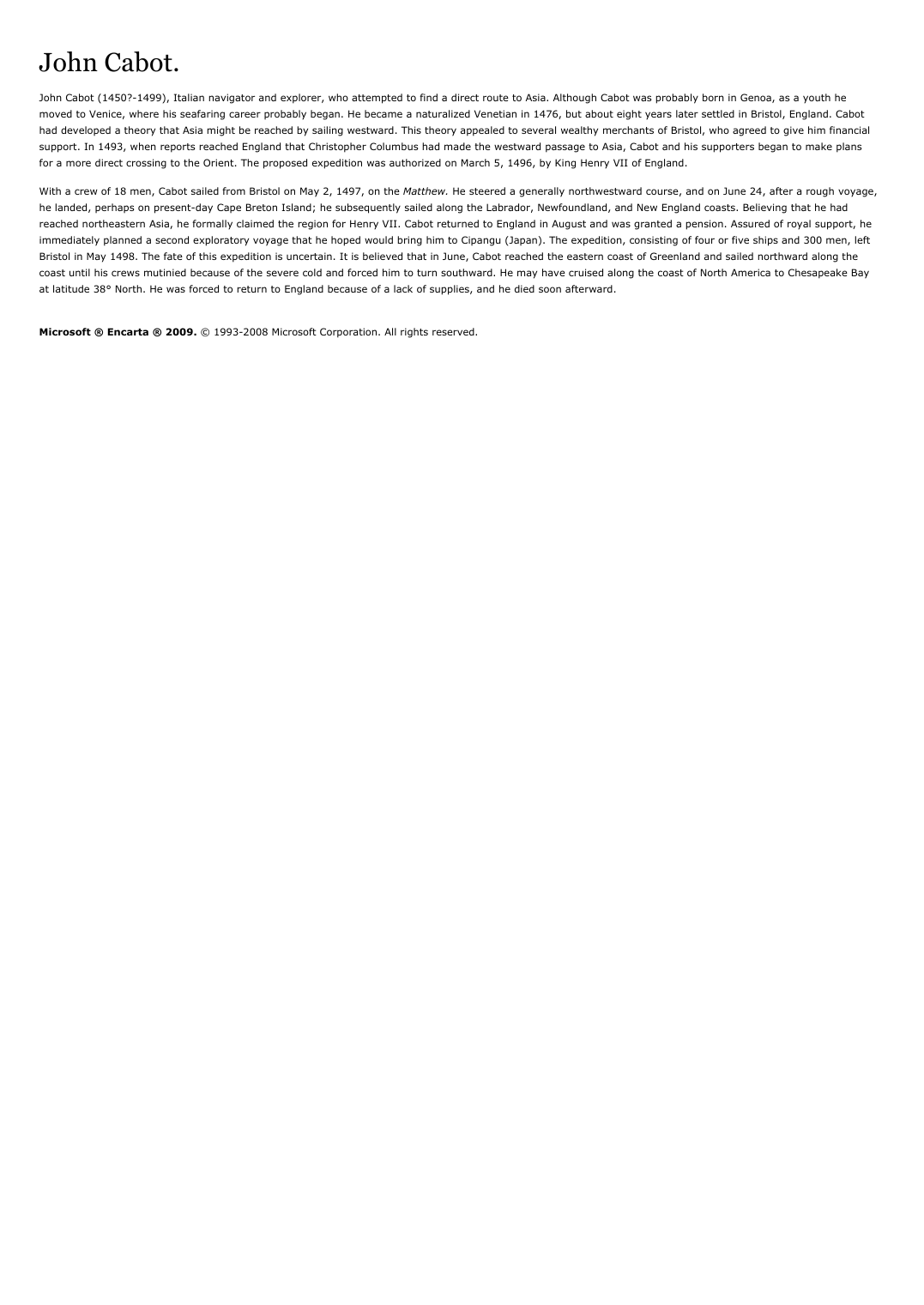John Cabot.
Publié le 06/12/2021

Extrait du document
Ci-dessous un extrait traitant le sujet : John Cabot.. Ce document contient 330 mots. Pour le télécharger en entier, envoyez-nous un de vos documents grâce à notre système d’échange gratuit de ressources numériques ou achetez-le pour la modique somme d’un euro symbolique. Cette aide totalement rédigée en format pdf sera utile aux lycéens ou étudiants ayant un devoir à réaliser ou une leçon à approfondir en : Echange
John Cabot.
John Cabot (1450?-1499), Italian navigator and explorer, who attempted to find a direct route to Asia. Although Cabot was probably born in Genoa, as a youth he
moved to Venice, where his seafaring career probably began. He became a naturalized Venetian in 1476, but about eight years later settled in Bristol, England. Cabot
had developed a theory that Asia might be reached by sailing westward. This theory appealed to several wealthy merchants of Bristol, who agreed to give him financial
support. In 1493, when reports reached England that Christopher Columbus had made the westward passage to Asia, Cabot and his supporters began to make plans
for a more direct crossing to the Orient. The proposed expedition was authorized on March 5, 1496, by King Henry VII of England.
With a crew of 18 men, Cabot sailed from Bristol on May 2, 1497, on the Matthew. He steered a generally northwestward course, and on June 24, after a rough voyage,
he landed, perhaps on present-day Cape Breton Island; he subsequently sailed along the Labrador, Newfoundland, and New England coasts. Believing that he had
reached northeastern Asia, he formally claimed the region for Henry VII. Cabot returned to England in August and was granted a pension. Assured of royal support, he
immediately planned a second exploratory voyage that he hoped would bring him to Cipangu (Japan). The expedition, consisting of four or five ships and 300 men, left
Bristol in May 1498. The fate of this expedition is uncertain. It is believed that in June, Cabot reached the eastern coast of Greenland and sailed northward along the
coast until his crews mutinied because of the severe cold and forced him to turn southward. He may have cruised along the coast of North America to Chesapeake Bay
at latitude 38° North. He was forced to return to England because of a lack of supplies, and he died soon afterward.
Microsoft ® Encarta ® 2009. © 1993-2008 Microsoft Corporation. All rights reserved.
John Cabot.
John Cabot (1450?-1499), Italian navigator and explorer, who attempted to find a direct route to Asia. Although Cabot was probably born in Genoa, as a youth he
moved to Venice, where his seafaring career probably began. He became a naturalized Venetian in 1476, but about eight years later settled in Bristol, England. Cabot
had developed a theory that Asia might be reached by sailing westward. This theory appealed to several wealthy merchants of Bristol, who agreed to give him financial
support. In 1493, when reports reached England that Christopher Columbus had made the westward passage to Asia, Cabot and his supporters began to make plans
for a more direct crossing to the Orient. The proposed expedition was authorized on March 5, 1496, by King Henry VII of England.
With a crew of 18 men, Cabot sailed from Bristol on May 2, 1497, on the Matthew. He steered a generally northwestward course, and on June 24, after a rough voyage,
he landed, perhaps on present-day Cape Breton Island; he subsequently sailed along the Labrador, Newfoundland, and New England coasts. Believing that he had
reached northeastern Asia, he formally claimed the region for Henry VII. Cabot returned to England in August and was granted a pension. Assured of royal support, he
immediately planned a second exploratory voyage that he hoped would bring him to Cipangu (Japan). The expedition, consisting of four or five ships and 300 men, left
Bristol in May 1498. The fate of this expedition is uncertain. It is believed that in June, Cabot reached the eastern coast of Greenland and sailed northward along the
coast until his crews mutinied because of the severe cold and forced him to turn southward. He may have cruised along the coast of North America to Chesapeake Bay
at latitude 38° North. He was forced to return to England because of a lack of supplies, and he died soon afterward.
Microsoft ® Encarta ® 2009. © 1993-2008 Microsoft Corporation. All rights reserved.
↓↓↓ APERÇU DU DOCUMENT ↓↓↓
Liens utiles
- explication de texte: John Locke a écrit en 1690 un essai philosophique concernant l’entendement humain, nous allons analyser un extrait du livre II, chapitre 27, paragraphe 26
- John Steinbeck
- Saint-John Perse
- Saint-John Perse
- John Wain


